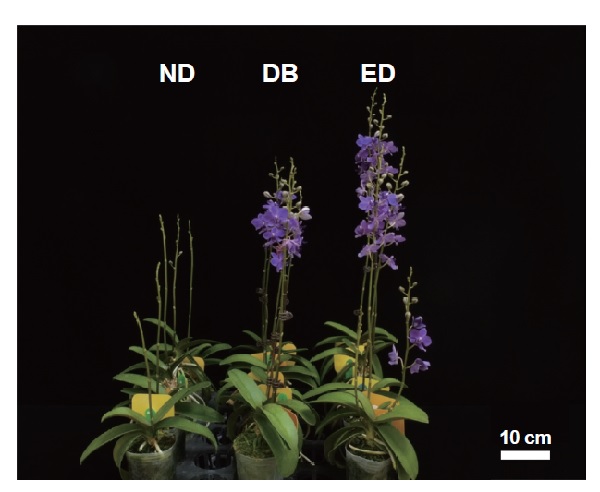All issues

Author:Jung-Yi Wu*, Yu-Wen Tsai, and Ting-En Dai
Abstract:
Indigo Phalaenopsis is rarely seen in the commercial market and just a few germplasm are available in the genus for indigo flower breeding. Rhynchonopsis Tariflor Blue Kid ‘1030-4’ with a deep and nonfading blue color has been bred successfully by intergenic hybridization. The purpose of this study is to discuss the effect of photoperiod on the flowering of Rhnps. Tariflor Blue Kid ‘1030-4’, and plan to regulate artificially the flowering period for commercial production. The results of the study showed that long-day treatments including extending day length (ED) and dark break (DB) could promote the early stalk emergence and flowering of Rhnps. Tariflor Blue Kid ‘1030-4’. Stalk emergence of plants treated with ED and DB were 45.5 d and 31 d earlier than natural day length (ND) treatment, respectively, and flowering time that was 34 d and 17 d earlier than control, respectively. ED has a better effect than DB on promoting stalk emergence and flowering. The number of flowers in the ED treatment (15.6 flowers) was significantly higher than that in the DB treatment (8.8 flowers) and control (ND) (5.9 flowers), however, there was no significant difference between DB and control. There was no significant difference in the flower diameter among the three treatments. The longest stalk (47.2 cm) in that of ED, followed by DB treatment (44.7 cm), while the shortest stalk of the control group (ND) was 37.2 cm. The inflorescence length also showed the same trend. The longest inflorescence (21.7 cm) in that of ED, followed by DB treatment (20.1 cm), while the shortest inflorescence appeared in the control (16.9 cm). The longest longevity of a single flower in ED was 20.1 d, followed by DB treatment (18.2 d), while the shortest longevity was 17.5 d.
Key words:Orchid, Daylength, Intergenus-hybridization, Flowering regulation
Download:![]() PDF Links
PDF Links
- 1. Using Digital Soil Mapping to Predict Soil Organic Carbon Stocks in Zhuoshui River Basin
- 2. Development of a Technique for Forecasting (or Pre-Detection) Anthracnose Disease Incidences of Green Mature Bagging Mango Fruits
- 3. Taxonomic Review of the Genus Asiophrida Medvedev, 1999 in Taiwan (Insecta: Coleoptera: Chrysomelidae: Galerucinae: Alticini), with Notes on Biology
 Submit your manuscript
Submit your manuscript
 Guide for authors
Guide for authors